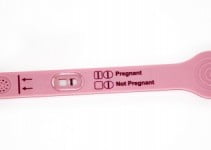
Though there are many kinds of pregnancy tests, but most women nowadays would start by testing at home, especially when they are expecting pregnancy or after having unprotected sex. At-home pregnancy provides a degree of freedom and privacy often needed in such cases.
Commonly available pregnancy tests at pharmacies require urine samples, as they test hCG hormone levels in the urine. Generally, the female body starts producing it in detectable amounts after about a week of fertilization.
Thus, it is no surprise that most women discover their pregnancy with the help of these over-the-counter pregnancy tests after about a week of getting pregnant. Fortunately, these tests are pretty reliable. In fact, they are 99% accurate.
Even if a test is negative and a person is expecting pregnancy, it is good to repeat the test after a week. It is quite possible that the first test came negative as a person tested too early.
Many find it difficult to resist when expecting pregnancy and may test before the recommended time. Further, there are individual differences. For example, a pregnancy test may show positive results a bit later in some cases.
However, in many cases, the result of a test may be pretty confusing, like either no line showing up, neither for positive nor for negative. It may be just blank.
Or one may see just a bleak positive line. Both of these results may leave a person scratching their heads and not knowing how to make sense of these tests.
Understanding the accuracy of pregnancy test
Firstly, one needs to understand what does the accuracy of tests means. When manufacturers say that their test is 99% accurate, do they mean for a positive or negative test?
Well, the claimed accuracy is for a positive test but not for a negative test. Thus, if both lines show clearly, chances are 99% that a woman is pregnant.
However, if a pregnancy test is negative, it does not mean that pregnancy can be ruled out in 99% of the cases. The accuracy of the negative test is much lower. Thus, the recommendation is to repeat a test after a week if expecting to get pregnant.
What about a blank pregnancy test?
 It depends on whether a person means the absence of second-line when expecting a pregnancy, or bleakly seen second strip, or not seeing any strip at all. Here we look at all the scenarios and possible causes.
It depends on whether a person means the absence of second-line when expecting a pregnancy, or bleakly seen second strip, or not seeing any strip at all. Here we look at all the scenarios and possible causes.
Let’s look at the first scenario when no strips are visible and the test is entirely blank.
The first strip is called a control strip. It has two purposes. First, to show that the pregnancy test was done correctly. Secondly, to ensure that the test is working, it has not expired or does not have some manufacturing defect. In short, if the test kit is working, the first line must show up.
Therefore, a completely blank test with the absence of any lines says that either the test kit is damaged, not working properly, or the test was not done correctly. Quite likely, a person did not pee appropriately on the test kit, and thus urine failed to reach its point.
However, if a person does see the first line, but not a second, then it says that the pregnancy test is negative. But, then one should keep in mind accuracy of the test is about positive results and not negative.
A negative test does not rule out pregnancy, as it may occur when the test was carried out just too early.
Therefore, in such a scenario, one should repeat the test after a week, especially when highly expecting a pregnancy.
However, a third scenario is also not less likely, when the second line shows up but is too bleak. In many cases, it will become darker if given some more time. In most cases, even a bleak red line indicates a positive pregnancy test. However, the line could be bleak as hCG levels are still too low.
If unsure, it is good to repeat a test after a week in such a case. Or one may go for a lab test, as they have higher accuracy.
Learn to use pregnancy tests accurately
Although most pregnancy tests come with very clear instructions, many fail to follow them in practice. Some might be in a hurry or for other reasons.
Almost all tests done at home are urine tests that sense the amount of hCG in urine. If the hormone is above a specific level, the test is positive. Generally, it is good to do two tests to make any conclusions. Additionally, it is a good idea to buy tests of different brands.
Many pregnancy tests sold at stores, though tested for their accuracy, they do not go through similar extensive testing as laboratory tests.
 First and foremost, always make sure that you use the first morning-urine. It is vital as morning urine has the highest concentration of various bioactive compounds, including hCG. Thus, such a test is much more accurate.
First and foremost, always make sure that you use the first morning-urine. It is vital as morning urine has the highest concentration of various bioactive compounds, including hCG. Thus, such a test is much more accurate.
Moreover, all the claims about the accuracy of pregnancy tests are about morning-urine samples. Accuracy of tests taken during other times of the day would vary significantly due to dilution of the urine.
Moreover, various foods consumed during the day are more likely to hinder the testing process. That is why even labs prefer morning urine samples.
Secondly, never open the testing kit beforehand. It should be strictly opened before carrying out the test. Else, environmental factors may cause degradation of the testing strip resulting the test failure. Usually, test strips must be used within a few minutes of opening.
Finally, do not rush. Instead, use the kit carefully and as per instruction by placing a few drops of urine at the indicated place.
To conclude, blank tests in most cases indicate one of the two things. The first possible reason is that the testing kit is defective; that is why even the control strip failed to show up. Or the second scenario could be that it was not used properly.
Thus, in the case of a completely blank result, it would be good to go for a second test using a different pregnancy test brand, and waiting for a week is not essential.




 Dr. Preet Pal SB is a physician (M.D. Medicine) with a specialization in diabetes (Fellowship in diabetes, Royal Liverpool Academy). He has a particular interest in metabolic disorders, considering that they are rising in every corner of the world, more so in India.
Dr. Preet Pal SB is a physician (M.D. Medicine) with a specialization in diabetes (Fellowship in diabetes, Royal Liverpool Academy). He has a particular interest in metabolic disorders, considering that they are rising in every corner of the world, more so in India.